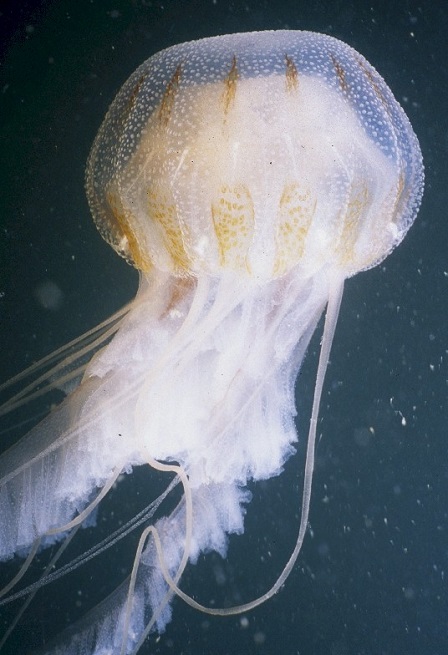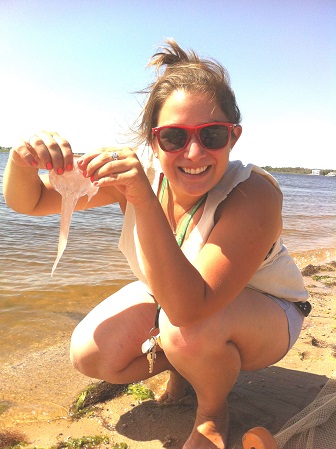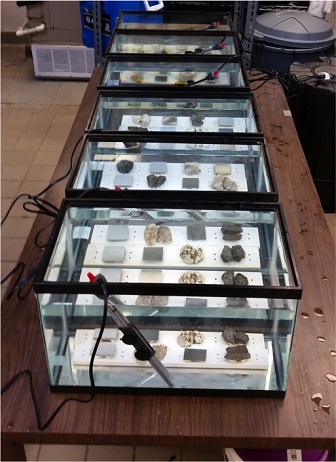By CHUCK BANGLEY
Chuck Bangley is a North Carolina Sea Grant-funded doctoral candidate in coastal resources management at East Carolina University. He tweets as @SpinyDag.
Nina Sassano used to be a research technician at the Barnegat Bay Partnership in New Jersey. Her tasks included monitoring barrier nets designed to keep jellyfish out of certain parts of the bay.

Atlantic sea nettles are the jellyfish species that is most commonly responsible for stinging bathers in North Carolina. Photo by Vicki Martin.
She was reminded the painful way that nematocysts, the stinging cells on jellyfish tentacles, will continue to sting even after the tentacle is detached from the body.
“I forgot that and wiped my hand across my face after handling some jellyfish,” Sassano — can be stung.
Some researchers have suggested that jellyfish blooms are increasing. In a frequently cited 2009 paper from the journal Trends in Ecology and Evolution, Australian marine biologist Anthony Richardson and his colleagues noted that the ocean may be headed for “a more gelatinous future,” caused by human-induced problems, such as overfishing and climate change.
However, there is no consensus over this conclusion. Convincing evidence that jellyfish are not on the rise has been offered by Rob Condon, a researcher at the University of North Carolina Wilmington.
Regardless, the exact factors leading to jellyfish blooms are still poorly understood.
David Kimmel, an ECU marine ecologist specializing in plankton ecology, is investigating this question. He and Sassano worked on a project, supported by a North Carolina Sea Grant minigrant, that may shed some light on one way that humans might contribute to local jellyfish blooms in estuarine ecosystems.
“There’s a perception that jellyfish are on the rise, but not a lot of empirical evidence,” Kimmel says. “We wanted to bring some data to the controversy.”
• Bringing Data to the Conversation
“Several environmental factors work together to create jellyfish blooms,” explains Sassano, who graduated in summer 2015. These may include eutrophication — where excess nutrient input into estuarine waters causes excessive plant growth — along with elevated water temperatures and declines in jellyfish predator populations.
However, one factor that may not seem obvious is the role of man-made structures in the environment. These include the bulkheads used to control estuarine shoreline erosion and boating infrastructure such as docks and pilings.
The Sea Grant funding enabled Sassano to study how these structures might contribute to jellyfish blooms. However, the work requires an understanding of the unique life cycle of jellyfish.

Nina Sassano studied sea nettle settlement for her master’s work at East Carolina University. Photo courtesy Nina Sassano.
Jellyfish have what scientists refer to as a biphasic — or two-phased — life cycle, which includes both sexual and asexual reproduction. First, two adult jellyfish spawn and create planula larvae, which travel through the water column until they find a surface on which to attach.
Once settled, they enter the polyp stage, when they resemble tiny flowers. Jellyfish may remain in this stage for years, and can form cysts around themselves to survive unfavorable environmental conditions.
When conditions are right, the polyps perform a process known as strobilation. They clone themselves by budding off free-swimming, medusa-stage individuals, which grow into the adult jellyfish recognized and feared by bathers.
“The polyp stage is probably the most important stage for jellyfish blooms,” Sassano says. If allowed to continue strobilating, a single months.
However, under ideal conditions, more polyps can grow in a particular area, producing even more medusa-stage jellyfish. Sassano sought to determine if an increase in surfaces favored by polyps could significantly contribute to the sometimes-explosive growth in jellyfish numbers.
“There’s always a possibility for a preferred substrate to lead to more jellyfish,” she explains.
Although rain washed out their 2014 field trials in the Neuse River estuary, Sassano also conducted lab experiments to test this hypothesis. In each of five tanks, she set up sections of two of four surface types that jellyfish polyps could grow on in North Carolina waters: oyster shell, rock, PVC plastic and stainless steel.
Oyster shells were used to represent natural substrate. The other surfaces used in the experiment represent materials used in shoreline stabilization or development. Sassano set the salinity in those tanks to 15 to 16 parts per thousand, approximately that of a brackish estuary, much like her field study areas in the lower Neuse River.
She then added encysted polyps of Atlantic sea nettle, Chrysaora quinquecirrha, the jellyfish species most commonly responsible for stinging bathers in North Carolina. By counting the number settling on each surface, Sassano was able to determine which surface in each pair was more hospitable to sea nettle polyps.
Sassano’s findings showed that sea nettle polyps settled in significantly greater numbers on man-made structures than on natural surfaces. Granite rock, representing material used to build riprap shorelines and rock jetties, and PVC plastic had greater polyp settlement than native oyster shell.
However, stainless steel outperformed all other materials as the preferred substrate for polyps, with over twice as many polyps settling on steel as the next most suitable surface, PVC plastic. The results of Sassano’s experiment seem to suggest that by hardening shorelines and introducing new materials into the water, especially with metal structures, humans may also increase the potential for local jellyfish blooms.
• A Piece of the Puzzle
Sassano’s research validates hypotheses put forth by other jellyfish researchers connecting man-made structures to the jellyfish life cycle. She suggests her results are likely only a small part of a much bigger picture.
“Substrate is just a piece of the puzzle,” she explains. While an increase in man-made structures and surfaces may create more suitable habitat for jellyfish polyps, many other environmental conditions must be right in order to create a jellyfish bloom.
Though polyps can survive cold temperatures and low salinities, in order to strobilate they require temperatures above 11 degrees Celsius or about 52 degrees Fahrenheit, and salinities between 11 and 20 parts per thousand, which is the typical summertime salinity range for the lower reaches of the Neuse and Pamlico Rivers.

Sassano set up five tanks in the laboratory each with two of four different surface types on which jellyfish polyps could grow. Photo by Nina Sassano.
As Sassano realized while attempting to find polyps growing in the lower Neuse River in 2014, a rainy summer can lower salinities enough to effectively prevent medusa production for an entire season — even if plenty of man-made substrate is available.
“Jellyfish go through large population fluctuations. They bloom then disappear the next season,” Kimmel explains. This boom-and-bust pattern makes it difficult to draw long-term conclusions about jellyfish populations. “We’re still figuring out what their behavioral connection to human activity even is.”
For her part, Sassano thinks that an increase in the amount of man-made structures in the water may cause jellyfish blooms to become more extreme, but not necessarily more common.
Even without long-term population increases, individual jellyfish blooms might have far-reaching ecosystem impacts. Adult jellyfish are voracious consumers of zooplankton and fish larvae. With few natural predators, jellyfish may out compete more important commercial and recreational fishes for energy — which is how scientists describe food in the food web.
Jellyfish that are part of a bloom also may all die off at the same time at the end of the season. A mass die-off — Sassano equates this event to laying down a blanket at the bottom of the waterbody — could throw off the balance of the nutrient-rich detritus, or dead organic matter, at the base of the food web.
These effects of a mass jellyfish die-off on the food web are difficult to account for because despite their importance in the ecosystem, Kimmel notes that there has not been a systematic study of jellyfish populations in North Carolina waters. Plankton surveys might mention the presence of jellyfish or ctenophores, also known as comb jellies, he adds, but they usually aren’t the target species.
Still, Sassano recommends that limits on new man-made structures and periodic cleaning of growth on existing bulkheads and docks may reduce the severity of future jellyfish blooms in North Carolina estuaries.
Though Sassano enjoyed conducting research, her main interest is in communicating with the public about marine and coastal science. She hopes to use her research experience to aid in future science outreach and education efforts.
Kimmel remains fascinated by gelatinous zooplankton, particularly jellyfish and ctenophores. He wants to study their unique place in the marine and estuarine ecosystems of North Carolina, particularly in the Neuse and Pamlico rivers.
“Looking at them might change the way we think about the food web,” Kimmel notes.
JELLYFISH ENCOUNTER
By Chuck Bangley
My most recent experience with jellyfish was not a pleasant one.
I was conducting a gillnet survey in the Pamlico River during the summer of 2012. Incidentally, this was my first project funded by North Carolina Sea Grant.
My team had noticed a few Atlantic sea nettles pulsing by in the water as we were setting the gear.
When the other crew members and I hauled the 300-yard gillnet back onboard, we found that it was completely clogged, from float line to lead line, with sea nettles. I had never seen so many in one place.
As we pulled in the net, we attempted to shake the net to dislodge some of them. But many jellyfish still made it on the boat, covering the bow of the vessel in a gelatinous layer of medusae and stinging tentacles.
Then the wind picked up. Soon the tentacles that had broken off were being blown straight at us, wrapping around our hands and arms, and even sticking to our faces.
One tentacle wrapped around my elbow and couldn’t be removed until we finished hauling in the net. It stung me so badly that it left a mark that didn’t start to fade for months.
To this day that incident remains the worst fieldwork experience I’ve ever had.
Read the three other stories in this series
- Minigrants: Fast, Simple, Noteworthy
John Fear highlights the strengths of the minigrant program. - Fishing for Funding
A minigrant helped a North Carolina business test an alternative crab bait. - Algae Patrol: Documenting a Changing Community
A researcher examines the arrival of tropical species.
This article was published in the Holiday 2015 issue of Coastwatch.
For contact information and reprint requests, visit ncseagrant.ncsu.edu/coastwatch/contact/.
